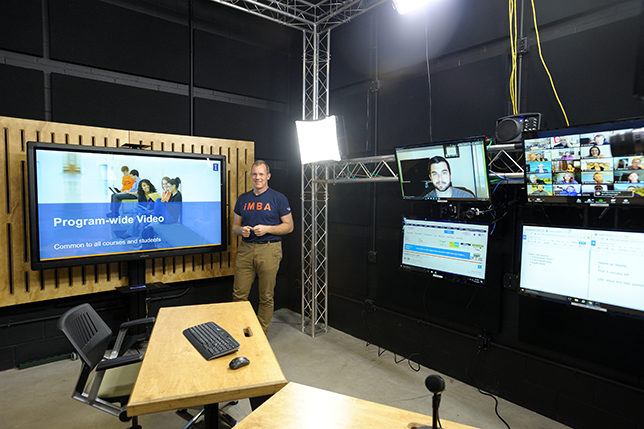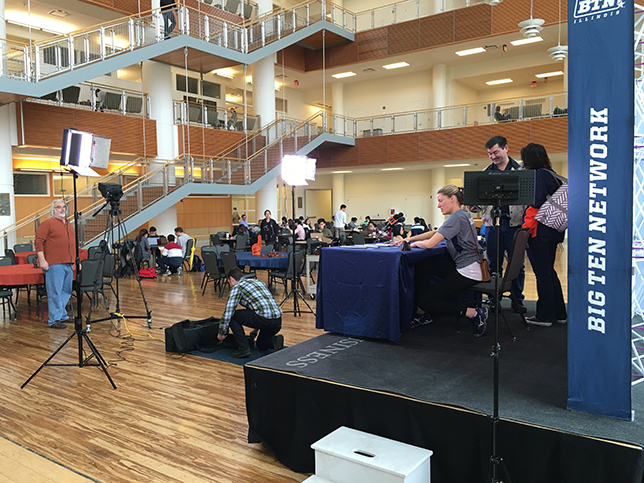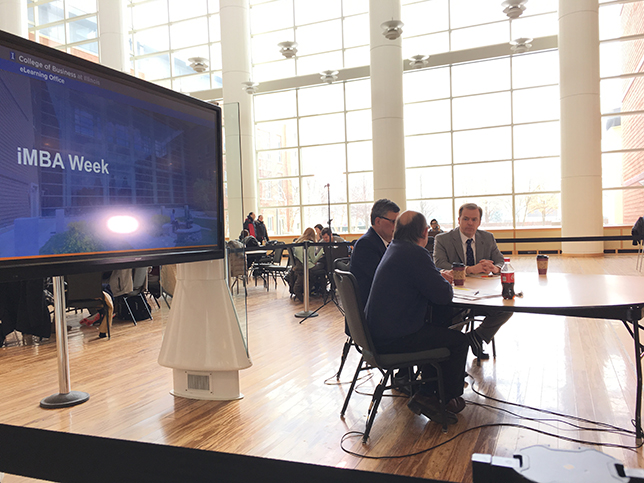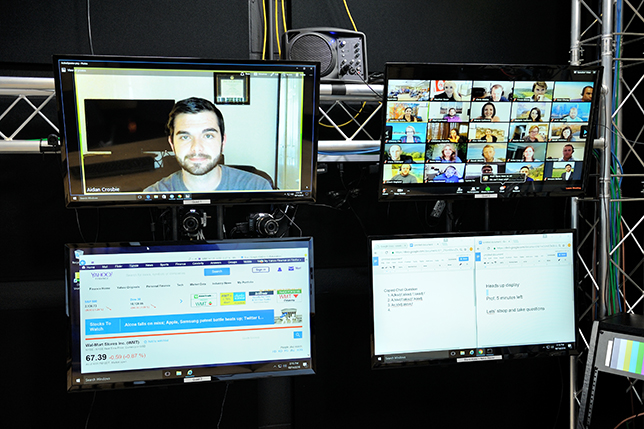How to Build a Production Studio for Online Courses
At the College of Business at the University of Illinois, video operations don't come in one size. Here's how the institution is handling studio setup for MOOCs, online courses, guest speakers and more.
- By Dian Schaffhauser
- 01/11/17

The University of Illinois Urbana-Champaign College of Business's video production studio (photo courtesy of UIUC)
When the University of Illinois Urbana-Champaign began running massive open online courses through Coursera, the institution quickly realized that the real power of those free courses was to introduce a world of prospective students to its campus programs — including the iMBA, its new online master's degree in business. The Digital Media team within the College of Business has played an important role in helping the college's production capabilities grow in quality and quantity. Now that team faces what may be its biggest challenge ever: accommodating up to 3,000 students in any particular online course.
Building up to that point has been an iterative process, said Digital Media Manager John Tubbs. The earliest video setup used for live sessions consisted of a webcam sitting on top of a 40-inch television monitor. "It was pretty crude," he recalled.
From there, Tubbs' operation grew into a fixed studio that could accommodate multiple camera views and presenters, green screen operations and teleprompting. He has found that well suited for specific kinds of productions, but not all. So the next iteration wasn't so much a studio as a mobile video outfit that could be set up to bring remote students to campus locations in innovative broadcast-caliber ways.
The college is in the process of finishing up two new studios to accommodate the latest production requirements, and their specs reflect all that Tubbs and his team have learned on the job, with a built-in assumption regarding explosive college growth.
The Primary Studio: 20x20 With Built-in Flexibility
The primary studio for the business school currently resides in a 400-square-foot space. The room incorporates a full-width green screen and a video monitor at stage right that allows instructors to see themselves interacting with words, charts, graphs or whatever else they're superimposed against.
Frequently, faculty like to work from a tablet, so the space also offers a podium that can be "rolled in for that situation," explained Tubbs. "They can have their digital stylus in hand, and we take a feed directly off that tablet and that goes into the recording as well." At the same time, a different camera angle is used for the tablet work to visually emphasize the shift from lecture to demonstration.
For Charlie Rose-like panel discussions or interviews, the same room can handle up to four people sitting and talking at a table. This setting is also used frequently for webinars geared toward recruitment.
Watching the Eyes
Because the room is fairly small, noted Tubbs, "we have to be very, very careful of our eye line" — the direction to which the instructor is reading and talking — "so they can keep their eyes going into the lens and they're not glancing over to a monitor that may be off to the side." In the case of the monitor's positioning on the stage-right wall used for a "weather person effect," Tubbs said, the eye line works because their body positioning is facing that monitor, which makes it "look correct to the student viewer."
Camera two — the center one — includes a monitor used as a teleprompter. Tubbs said that some faculty like to work from "full written-out word-for-word scripting" for their lectures. Others prefer bullet points, so they use the teleprompter screen for their presentation slides. The stage-right monitor can mirror that same content to allow presenters to see themselves "immersed."
The video team relies on Blackmagic hardware: 4K Studio Cameras connected via an ATEM 1/ME switcher to HyperDeck Studio disk recorders, which capture everything coming into the program — camera feeds, content feeds and audio. The studio director for the session works from a broadcast panel, which provides a tactile interface for switching between camera and other feeds.
During live sessions, teaching assistants help the instructors by acting as "Ed McMahons," as Tubbs calls them. "They're actually on camera, on mic, participating, but they are not the lead person. They're the sidekick, saying, 'Ah, professor, we have a question coming in from Mumbai...'"
A Three-Story Studio for a Different Kind of Experience
Sometimes, the studio experience isn't the right fit for the kinds of videos Tubbs needs to produce. In those cases the team uses a mobile setup with three cameras that can be rolled onto the set, wherever that might be. The mobile outfit mirrors the equipment of the fixed studio. That way the location work uses the same Blackmagic gear and same technical skill set as the studio.
A prime backdrop is the business school building, a LEED platinum-certified facility that stands three stories tall with a panoramic view out onto a courtyard. "Our opportunities for location shots all over that building are bountiful," said Tubbs. The setting is optimal for a number of video types: First, there are the welcome videos for MOOCs, in which the instructors are presented explaining to potential students what they can expect in the course. Those might include "dramatic shots, like the faculty member walking down the grand staircase in that room and coming to the camera," he said.

Recording in the business school building atrium (photo courtesy of UIUC)
The building's atrium serves as a setting for iMBA Week, a business-focused spin-off of Sunday morning political television programs, used to generate interest in UIUC's MOOC and iMBA credit-bearing courses. According to Tubbs, each show includes a panel of faculty experts discussing timely stories of interest to iMBA students, such as funding for higher ed and Volkswagen's "dieselgate." For the latter story, for instance, a professor of economics came on to talk about the effects of the scandal on the company's fortunes; another faculty member who teaches leadership courses in business administration discussed what the CEO of VW faced as he tried to pull the company through the debacle. The whole program was moderated by Raj Echambadi, the senior associate dean of MBA Programs & Strategic Innovation and a professor of finance.
Rather than recording those sessions in a studio, which, as Tubbs explained, can be a "little stifling, especially for a show that you want to have more fun and be wide open," they were captured directly in the atrium. "Middle of the day at lunch hour, buzzing all over the place in the background, just like when you watch the Today Show on NBC in the morning and you can see all the people in Rockefeller Center waving their hands. We don't care that there's a little murmur in the background. We don't care that students are walking behind the stage."

The iMBA Week show is produced in the midst of the buzz of the busy business school building atrium. (photo courtesy of UIUC)
"Because they're like case studies," added Tubbs, "we can use them over and over again. But when they're first shown, it's all about being current [and connected] to what students are seeing in the news at the time they're taking classes from these instructors."
Testing the Format
iMBA Week was an experiment this year. The show will be tweaked in the future to get more iMBA students involved, for example, by having them prepare the questions for the subject-matter experts.
A third use for the atrium setting is to record "eminent speakers," successful alumni who answer questions about their experiences and work. A recent speaker was Keith Bruce, marketing graduate and producer of Super Bowl 50, who was interviewed by Echambad. "Rather than putting them into a really highly controlled studio environment, where do we record them? Overlooking our beautiful atrium, from the second floor balcony. We took advantage of the building," declared Tubbs.
New Studios: Designed for Student Presence
The college is now operating in its newest studio, which has been designed for program growth — but also for feeling.
"For me, the MOOC lectures have to be absolutely perfect," explained Tubbs. "But when we bring [students] from that on-demand world into our high-engagement, high-touch, credit-bearing iMBA world, we need to bring relevance — what's relevant on the outside with current events and also what's relevant to those students at that particular time in their coursework. That's why our new studios will feature up to 100 student heads simultaneously displayed in front of the instructor. The instructor needs to be able to feel the students in front of him or her."
Achieving that goal is where additional technology and experienced staff come into play. Alongside a trio of Blackmagic Micro Studio cameras and a control board, the college has also added two 70-inch touchscreens and four 32-inch monitors.

Monitors in the new studio (photo courtesy of UIUC)
One of the large displays enables faculty members to "walk up to a 70-inch whiteboard and show their slides, pull out a digital stylus and ink right on that screen," said Tubbs. "They can be standing and doing that. They can also be seated and presenting with the slide over their shoulder on a second 70-inch screen. So it's a much more movement-driven, interactive environment for the instruction. We want to make these fun for the instructor."
The smaller displays have multiple uses. One or two will be hooked to computers running Zoom online meeting software to enable instructors to view and interact with their students. One will always display the active speaker from the Zoom session. Another monitor shows two shared Google docs, one with selected student questions from the Zoom chat and the other a "private" message screen for instructor/TA communication. Tubbs said the remaining monitors can display applications such as "Excel, browsers, slides that are pushed into the Zoom video feed, a second Zoom student display with the 'Brady Bunch' grid view, a duplicate view of any other monitor or, optionally, a feed from one of the other studios. Our goal is to be able display any source — any of the three cameras and any of the five computers on any display for the instructor."
To make sure the courses run smoothly, a studio director is on hand to control the cameras (set on articulated arms), pull a given image into the feed, turn screen sharing on and off and juggle the given permutations of video inputs going to Zoom. An additional corps of three or four TAs sits in on the Zoom session outside the studio to triage questions, muting student mics and answering queries that don't need to be asked in front of the class. A studio TA continues acting as a sidekick. And the instructor can simply focus on the lecture and interaction with students.
For the Record
Recorded lectures are posted almost immediately using the Kaltura video platform. As a class is delivered, it's recorded in Zoom and shuttled through a connector to Kaltura, which immediately tags it with course metadata, compresses the file and automatically publishes it as a low-resolution recording. A Digital Media team member or TA then logs into Kaltura and eliminates the "junk" at the beginning and end of the recording, generated before the class session officially began and after it ended. In a second phase the video editor produces a high-resolution version of the recording to replace the low-res version, usually by the next day.
So far, said Tubbs, feedback from the faculty is positive. He recalls one veteran professor coming to him after the first couple of sessions and saying, "I love having all those faces in front of me. I feel like they're there. I can see — without them even talking — if they're understanding what I'm saying."
Program Growth
So where does the multi-thousand-student count come in? That was the planning challenge given by the dean to Tubbs more than a year ago, as he began designing the new studios. "He told me, 'John, you need to plan for a student body in any particular course of 3,000,'" Tubbs explained.
The initial cohort of the iMBA was about 120 students, brought online in January 2016. A second cohort was added in August, doubling the student count. As of January 2017, three cohorts are in play. The university has built a second studio, with adjustments made based on its experience from the first studio.
To accommodate a global class of students living in multiple time zones, each live session is presented twice a week (say, on a Friday night and a Saturday morning or Saturday night and Sunday morning). While the content for those classes is required, attendance isn't, which means some students won't show up. That makes the live-session recordings crucial and time sensitive, said Tubbs.
A Sanctioned Back Channel
In order to keep the Zoom session's text chat focused on the class discussion at hand, the college encourages students to take other discussions to a separate back channel. To this end, the college has adopted Slack, a messaging app for teams, which is integrated with each student's Zoom meeting ID for video conversations outside of class. Students frequently use Zoom to meet in study groups or project teams. "They like the flexibility," noted Tubbs. "They like the open door policy we're making toward our conferencing system. They can do whatever they want whenever they want, which I think is a great plus."
At some point, though, Zoom's magical number of 500 simultaneous attendees will be breached and the college will convert from the vendor's online meeting mode to webinar mode. Up to 3,000 people can attend, but only 25 can be invited as "panelists" for onscreen presence. The others will participate in view-only mode, which means they can listen and watch and text chat. Tubbs anticipates groups of students being moved into and out of the panel during a large group class session. The team is in the early stages of development of middleware for user management that will automate students going from the virtual lecture hall to the smaller classroom and back.
While the expansion will work from a technology standpoint, Tubbs is concerned about maintaining a "high-touch environment." To enable that, he said, the college may need to start adding "specialized faculty" (non-tenured adjuncts) with professional experience "to satisfy that human side of our scaling process." The primary faculty will then be in a position to teach the "broad, large-lecture courses" and the other faculty will teach to smaller groups. Both they and the TAs will act as conduits to the professor for the course-wide questions that come in.
Through the evolution, however, the production team is keeping one goal in mind: to make the new studios "feel as natural as possible" for all concerned. When it comes to instruction, faculty behavior is going to be "significantly different" in an online course than in a MOOC, said Tubbs. "We want that experience to transfer over to the students so they feel like now that they're accepted as credit-taking students in the program, they're getting more value."